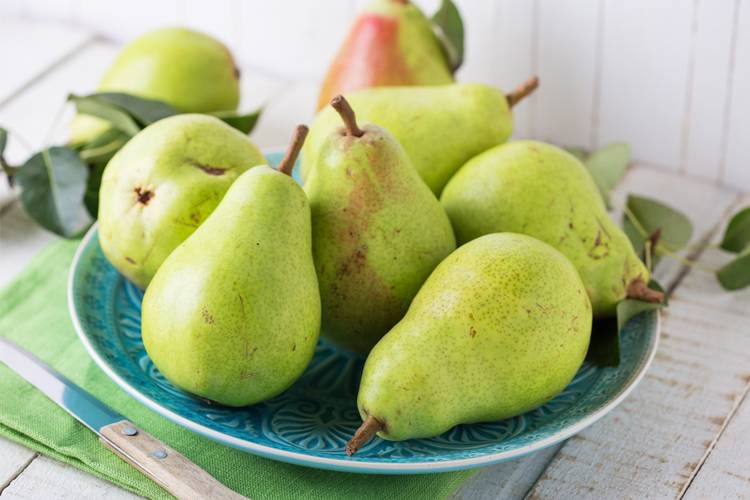The properties of the pear that you did not know
The properties of the pear make it an ideal food in any type of diet. Recognizable and refreshing from the first bite, the pear is usually eaten as a dessert and is increasingly appreciated in elaborate dishes to which it provides a particular touch.
fresh food
Share

Before starting to talk about the properties of the pear, it is interesting to know its origin. This is located in the regions of southeastern Europe and western Asia, and for this reason, it is a typically Mediterranean fruit. In fact... did you know that in the documents that speak of Magna Graecia there is extensive talk about its consumption? This is not surprising, since, in addition to being delicious, it has multiple properties that benefit our health. Next, we will talk about the properties of the pear and all the varieties that exist.
Benefits of pears for your health
The pear is one of the most consumed fruits in our country and it is not for less, since they have multiple properties that benefit our health, take note of them!
1. High water content: pears have a high water content, since 85% of their weight is. This helps us eliminate excess toxins from our body, in addition to favoring the urinary tract.
2. Few calories: Like most fruits, having a high water content, pears have very few calories, so they are recommended in most weight loss diets.
3. Source of fiber: pears have a high fiber content, which makes them a highly recommended fruit for all those with digestive problems or constipation, as they facilitate intestinal transit.
4. High content of potassium and calcium: pears have a high content of potassium, which helps us maintain normal blood pressure. In addition, pears are rich in calcium, which helps maintain strong bones, especially during childhood and after menopause.
5. Antioxidant properties: Pears have appreciable amounts of vitamin C, which protects cells against oxidative damage. In addition, they contain flavonoids such as beta-carotene, lutein and zeaxanthin, which allow us to get rid of free radicals produced by oxidative stress, which is one of the main causes of premature aging.
6. Anti-inflammatory properties: pears have a large amount of flavonoids, which reduce intestinal inflammation.
Pears with denomination of origin
Pear production is quite widespread worldwide. This is evidenced by the pear crops in China, the plantations of the countries of the European Union and the crops of this fresh fruit in the countries of North and South America. In Spain, the Ercolini pears from Jumilla (Murcia), the Conference pears from Rincón de Soto (La Rioja) and the Conference and Blanquilla pears from Lérida (Catalonia) have denomination of origin.

Types of pears: varieties to choose from
Within the different varieties of pear in the world, we can find soft or hard pears, suitable for fresh consumption or special for cooking. Its shape varies from the most rounded shapes to the thinnest and most elongated, and in some cases even curved. Today, there is a wide variety of pears with different sizes and a wide range of colors, although currently only certain types are grown that can be consumed at certain times of the year. We show you the varieties of pear that you cannot miss… And when to consume them!
Spring-summer
• Ercolini pear (D.O Jumilla): medium size, thin skin, yellow color on a green background and reddish areas.
• Pear Magallona: green and reddish tones. Hard and sweet meat. It is similar to that of San Juan, but larger.
• Pear Castell (also called San Juan): small size, they have a yellowish-green skin with a red veneer. It is the earliest pear of the summer season.
• Lemon pear: yellow color with black dots. It is the most refreshing pear in the summer months.
Of winter
• Alejandrina pear: large and greenish in color that changes to yellow when ripe.
• Blanquilla Pear: medium size, also known as water pear. Smooth skin and very small heart.
Of the whole year
• Conference Pear (D.O.Rincón de Soto): it is characterized by the oxidation of its skin. Its flavor is sweet, with a minimum of acidity.
Conservation tips for pears
Pears are delicate and perishable fruits. Those that are in the process of maturation should be kept at room temperature, and once the desired point of maturation has been reached, it is best to consume them immediately or keep them in the refrigerator for a maximum of four days. This fruit emits a gas called ethylene during its maturation, which accelerates its deterioration, which is why some pieces should not be stacked on top of others or kept in airtight containers. This way they will stay in good condition for longer.
Another interesting conservation tip: to prevent pears from turning yellow, after peeling they can be submerged in cold water with a dash of lemon juice to maintain their color.
Recipes with pears
Pear cake
Ingredients
• Baking paper
• 1 sheet of round puff pastry
• 7 pears
• 60 g of butter
• 50 g of flour
• 1 teaspoon baking powder
• 120 g of icing sugar
• 30 g of ground almonds
• 1 tablespoon of sliced almonds
• 2 tablespoons of whole milk
• 1 egg
• Apricot jam, peach jam or plum jam
• Water
• 1 lemon
Step by step recipe
1. Line the baking tray with parchment paper.
2. Spread the puff pastry sheet on top of the baking tray and cover it with another layer of parchment paper. Add some dry chickpeas so that the puff pastry does not swell.
3. Put the tray in the oven at 200º C, after 15 minutes, remove the tray from the oven.
4. Let the puff pastry cool while you grate the skin of a lemon.
5. Peel the pears without removing the stem and core them.
6. Cook the pears in water with two tablespoons of sugar for 10 minutes.
7. Remove the pears from the water and let them cool.
8. In a bowl, beat an egg with the wire mixer and add the softened butter. Next, pour the milk into the mixture along with the lemon zest. Later, add the flour, the yeast and the ground almonds (without stopping stirring with the rod blender)
9. Pour this dough over the baked puff pastry and spread it over the base.
10. Place the pears, split lengthwise in half, on the dough and fill the holes with the sliced almonds.
11. Bake the cake at 200º C for 20 minutes.
12. Spread the surface of the cake with the jam of your choice once it has cooled.
Pear galette
Ingredients
• 255 g of flour
• 170 g of cold butter
• 3 g of salt
• 100 g of cream cheese
• 10 g of apple cider vinegar
• 3 pears
•1 egg
• 12 g of sugar
• 150 g of goat cheese
• 20 g of brown sugar
• 20 g of shelled walnuts
•Honey
•Nutmeg
Step by step recipe
1. In a bowl, mix the flour, the salt, add the butter (better cold) and the cream cheese, mix everything with the help of a spatula or with a rod mixer. Add the apple cider vinegar, 15 ml of the water and mix the mixture well until it is unified. Cover the dough with plastic and store it for 30 minutes in the fridge.
2. Put the goat cheese, sugar, honey, chopped walnuts and nutmeg in a bowl and mix well with a wire mixer.
3. Line the baking tray with parchment paper and stretch the dough into a 12-inch circle, place the goat cheese mixture, keeping it slightly off the edge. Make some folds around the dough.
4. Cut the pears into vertical slices and place them in the mixture.
5. Paint the dough with a beaten egg and sprinkle it with sugar around it.
6. Bake the pear galette for 25 to 30 minutes.
7. After the baking time, paint the edges of the dough with honey.
8. Let cool before serving.







